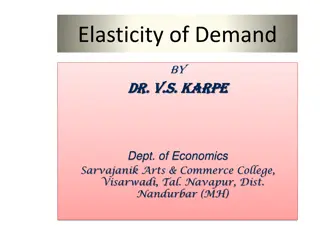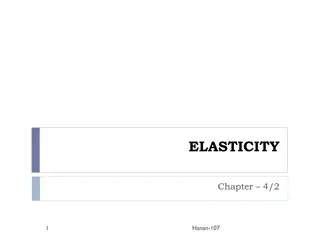Understanding Price Elasticity of Demand in Economics
Explore the concept of price elasticity of demand in economics through a discussion on how changes in pricing can impact revenue generation. Learn about different types of demand elasticity and how to calculate price elasticity of demand using the percentage change in quantity demanded and price. Discover the significance of elasticity at different points on a demand curve and the use of the midpoint formula for accurate calculations.
Uploaded on Nov 13, 2024 | 0 Views
Download Presentation

Please find below an Image/Link to download the presentation.
The content on the website is provided AS IS for your information and personal use only. It may not be sold, licensed, or shared on other websites without obtaining consent from the author. Download presentation by click this link. If you encounter any issues during the download, it is possible that the publisher has removed the file from their server.
E N D
Presentation Transcript
A good video to review and go a little deeper with Price Controls https://www.youtube.com/watch?v=01lKDkYS FDg 2
Question for thought: Imagine that you are part of the management team for Econsoft, a computer software company. You are discussing one of your products, Econblaster, with the company s CEO and the other managers. You have made the software available for download on your firm s website for download for $9.99 and you are trying to figure out how to generate more revenue from the product. Half of the management team suggests increasing the price to $11.99. The other half advocates cutting the price to $7.99. Both sides claim that their idea will increase total revenue generated from the product. What do you think? What does the right answer depend on? 3
Elasticity: The responsiveness of one variable to changes in another Such as 4
Price elasticity of demand is a measure of how much the quantity demanded of a good responds to a change in the price of that good. Price elasticity of demand is the percentage change in quantity demanded given a percent change in the price. It is computed as: Ed = Percentage change in quantity demanded/ Percentage change in price 5
Demand can be inelastic or elastic Inelastic Demand Quantity demanded does not respond strongly to price changes Price elasticity of demand is less than one |Ed|<1 (why abs val?) 6
Elastic Demand Quantity demanded responds strongly to changes in price. Price elasticity of demand is greater than one |Ed|>1 7
Unit Elastic Quantity demanded changes by the same percentage as the price. |Ed|=1 8
Note that elasticity will be different at every point on a demand curve (depends on which direction you are going!) The midpoint formula gives the same answer regardless of the direction of the change. Price elasticity of demand = (Q2-Q1) / {(Q2+Q1)/2} --------------------------------- (P2-P1) / {(P2+P1)/2} 9
If the price of an ice cream cone increases from $2.00 to $2.20 and the amount you buy falls from 10 to 8 cones. Using the midpoint formula, let s calculate Ed. First we need to define Q1, Q2, P1, and P2 Q1=10, P1=$2 Q2=8, P2=$2.2 The important part is to make sure you match up P1 with Q1 and P2 with Q2. 10
Now just plug the values into our simple formula: [(8-10)/(8+10)]/2 (8-10)/(8+10) -2/18 ------------------------- = -------------------- = -------- [(2.2-2)/(2.2+2)]/2 (2.2-2)/(2.2+2) 0.2/4.2 =-2.33 11
Another one for practice: At price $5, Qd is 50 units At price $4, Qd is 100 units Calculate Ed -3 Demand is price elastic (in this range) 12
Because the price elasticity of demand measures how much quantity demanded responds to the price, it is closely related to the slope of the demand curve But don t make the mistake of thinking they are the same! (slope does NOT equal Ed) 13
We can, however, tell the relative elasticities of two demand curves by their relative slopes Flatter-> more elastic 14
Perfectly Inelastic Quantity demanded does not respond to price changes at all Perfectly Elastic Quantity demanded changes infinitely with any change in price 15
Perfectly inelastic demand: Q won t change at all with P What will this look like? What will the Ed coefficient equal? 16
Perfectly elastic demand: Qd goes to zero if you increase the price by any amount What will this demand curve look like? What will the Ed coefficient equal? 17
What are some things that affect Ed? 1) Availability of close substitutes 18
2) Degree to which the product is a luxury vs. necessity Necessity: % of income spent on the good as income Luxury: % of income spent on the good as income 19
3) Narrowness of the market Ed will be greater the narrower you define the mkt Think about petrol in general vs. petrol from a specific petrol station 21
4) How long do consumers have to adjust? (time horizon) The longer the time period, the higher the Ed is likely to be 23
Time horizon: demand for gas Price for gas Short term effect: Demand for gas drops, but people still have to run errands, drive to work, etc. so impact is small Long term effect: Demand falls even further as people switch to other modes of transportation and buy more efficient cars so impact is bigger 24
5) The share of income spent on a good What if the price of table salt doubled? 25
There is an important relationship between TR and Ed Total revenue is the amount paid by buyers and received by sellers of a good Computed as the price of the good times the quantity sold TR = P x Q 26
Two things happen when a firm raises prices, one good and one bad (from the firm s perspective) Positive effect on revenue: Higher price allows to bring more revenue per item sold Negative effect on revenue: Higher price lowers quantity demanded (law of demand) Q: What is the total effect? 28
With an inelastic demand curve (elasticity < 1), an increase in price leads to a decrease in quantity that is proportionately smaller. Thus, total revenue increases 29
With an elastic demand curve (elasticity > 1), an increase in the price leads to a decrease in quantity demanded that is proportionately larger. Thus, total revenue decreases 31
Income Elasticity Income elasticity of demand measures how much the quantity demanded of a good responds to a change in consumers income It is computed as the percentage change in the quantity demanded divided by the percentage change in income Yd= (% change in Qd) / (% change in income) 34
Normal Goods Consumption of normal goods increases with income Normal goods have positive income elasticity Inferior Goods Inferior Goods Consumption of inferior goods decreases with income Inferior goods have negative income elasticity 35
Calculate income elasticity John s income rises from $20,000 to $28,000 and the quantity of apples he buys each week falls from 2 pounds to 1 pound What is the income elasticity of apples for John? Are apples a normal or inferior good for John? -2, inferior 36
Cross Price Elasticity Cross-price elasticity of demand The percentage change in the quantity demanded of one good caused by 1 percent change in the price of another For goods X and Y: Cross price elast of demand % change in quant demanded for good x = ----------------------------------------------- % change in price of good y 37
What will the cross price elasticity be between the number of times Dr. Beck eats in the cafeteria here and the price of tea in China? 38
Cross price elasticity can be positive or negative X and Y are complements if Cross price elasticity is negative X and Y are substitutes if Cross price elasticity is positive 39
Elasticity of Supply Price elasticity of supply is a measure of how much the quantity supplied of a good responds to a change in the price of that good Price elasticity of supply is the percentage change in quantity supplied resulting from a percent change in price Es= (% change in Qs) / (% change in price) 40
Will depend on ability of sellers to change the amount of the good they produce Beach-front land is inelastic Books, cars, or manufactured goods are elastic Time horizon Supply is more elastic in the long run. 45
Will elasticities affect the magnitude of price swings? Natural gas 46
Practice Questions Evaluate the following statement. Milk is a basic staple for most households and the demand for milk is thus very inelastic. Because of this, Borden Dairy should increase the price of their Borden Brand milk significantly as to generate much more revenue. Do you agree? Is this likely to generate a lot more revenue for the firm? Why or why not? 47
Consider three different goods/services: lawn mowings, nuclear power plants, and computer programs. Think about the period of over the next 2-3 years, and rank them from the most elastically supplied to the least elastically supplied. Explain your answer. For a given increase in demand, which will result in a larger increase in equilibrium price: the case where the elasticity of supply is very low or the case where the elasticity of supply is very high? (hint: graph the situation with first a low, then a high elasticity of supply) 48
Some firms, like Walmart and fast-food restaurants, often see their revenues and profits increase during tough economic times. Explain this using terms and concepts from this module. 49
Imagine the elasticity of demand for entry into your nightclub is -1.9. If you wanted to increase total revenue generated from admission, would you increase or decrease the price? Why? Imagine the elasticity of demand for entry into your art gallery is -0.7. If you wanted to increase total revenue generated from admission, would you increase or decrease the price? Why? 50























